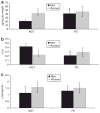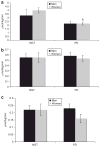Altered intramuscular lipid metabolism relates to diminished insulin action in men, but not women, in progression to diabetes
- PMID: 20379150
- PMCID: PMC3230250
- DOI: 10.1038/oby.2010.76
Altered intramuscular lipid metabolism relates to diminished insulin action in men, but not women, in progression to diabetes
Abstract
Whether sex differences in intramuscular triglyceride (IMTG) metabolism underlie sex differences in the progression to diabetes are unknown. Therefore, the current study examined IMTG concentration and fractional synthesis rate (FSR) in obese men and women with normal glucose tolerance (NGT) vs. those with prediabetes (PD). PD (n = 13 men and 7 women) and NGT (n = 7 men and 12 women) groups were matched for age and anthropometry. Insulin action was quantified using a hyperinsulinemic-euglycemic clamp with infusion of [6,6-(2)H(2)]-glucose. IMTG concentration was measured by gas chromatography/mass spectrometry (GC/MS) and FSR by GC/combustion isotope ratio MS (C-IRMS), from muscle biopsies taken after infusion of [U-(13)C]palmitate during 4 h of rest. In PD men, the metabolic clearance rate (MCR) of glucose was lower during the clamp (4.71 ± 0.77 vs. 8.62 ± 1.26 ml/kg fat-free mass (FFM)/min, P = 0.04; with a trend for lower glucose rate of disappearance (Rd), P = 0.07), in addition to higher IMTG concentration (41.2 ± 5.0 vs. 21.2 ± 3.4 µg/mg dry weight, P ≤ 0.01), lower FSR (0.21 ± 0.03 vs. 0.42 ± 0.06 %/h, P ≤ 0.01), and lower oxidative capacity (P = 0.03) compared to NGT men. In contrast, no difference in Rd, IMTG concentration, or FSR was seen in PD vs. NGT women. Surprisingly, glucose Rd during the clamp was not different between NGT men and women (P = 0.25) despite IMTG concentration being higher (42.6 ± 6.1 vs. 21.2 ± 3.4 µg/mg dry weight, P = 0.03) and FSR being lower (0.23 ± 0.04 vs. 0.42 ± 0.06 %/h, P = 0.02) in women. Alterations in IMTG metabolism relate to diminished insulin action in men, but not women, in the progression toward diabetes.
Conflict of interest statement
The authors declared no conflict of interest.
Figures




Similar articles
-
Fenofibrate administration does not affect muscle triglyceride concentration or insulin sensitivity in humans.Metabolism. 2011 Aug;60(8):1107-14. doi: 10.1016/j.metabol.2010.12.003. Epub 2011 Feb 8. Metabolism. 2011. PMID: 21306746 Free PMC article.
-
Inflexibility in intramuscular triglyceride fractional synthesis distinguishes prediabetes from obesity in humans.Obesity (Silver Spring). 2010 Aug;18(8):1524-31. doi: 10.1038/oby.2009.454. Epub 2009 Dec 24. Obesity (Silver Spring). 2010. PMID: 20035285 Free PMC article.
-
Intramuscular lipid metabolism in the insulin resistance of smoking.Diabetes. 2009 Oct;58(10):2220-7. doi: 10.2337/db09-0481. Epub 2009 Jul 6. Diabetes. 2009. PMID: 19581421 Free PMC article.
-
Increased intramuscular lipid storage in the insulin-resistant and endurance-trained state.Pflugers Arch. 2006 Feb;451(5):606-16. doi: 10.1007/s00424-005-1509-0. Epub 2005 Sep 10. Pflugers Arch. 2006. PMID: 16155759 Review.
-
[Insulin resistance: the role of intramuscular triglyceride and the importance of physical activity].Ned Tijdschr Geneeskd. 2006 Jan 21;150(3):122-7. Ned Tijdschr Geneeskd. 2006. PMID: 16463611 Review. Dutch.
Cited by
-
Estrogen treatment after ovariectomy protects against fatty liver and may improve pathway-selective insulin resistance.Diabetes. 2013 Feb;62(2):424-34. doi: 10.2337/db11-1718. Epub 2012 Sep 10. Diabetes. 2013. PMID: 22966069 Free PMC article.
-
Fenofibrate administration does not affect muscle triglyceride concentration or insulin sensitivity in humans.Metabolism. 2011 Aug;60(8):1107-14. doi: 10.1016/j.metabol.2010.12.003. Epub 2011 Feb 8. Metabolism. 2011. PMID: 21306746 Free PMC article.
-
Relative Contribution of Intramyocellular Lipid to Whole-Body Fat Oxidation Is Reduced With Age but Subsarcolemmal Lipid Accumulation and Insulin Resistance Are Only Associated With Overweight Individuals.Diabetes. 2016 Apr;65(4):840-50. doi: 10.2337/db15-1383. Epub 2016 Jan 6. Diabetes. 2016. PMID: 26740597 Free PMC article.
-
Ectopic Fat Accumulation in Distinct Insulin Resistant Phenotypes; Targets for Personalized Nutritional Interventions.Front Nutr. 2018 Sep 4;5:77. doi: 10.3389/fnut.2018.00077. eCollection 2018. Front Nutr. 2018. PMID: 30234122 Free PMC article. Review.
-
Skeletal muscle triglycerides, diacylglycerols, and ceramides in insulin resistance: another paradox in endurance-trained athletes?Diabetes. 2011 Oct;60(10):2588-97. doi: 10.2337/db10-1221. Epub 2011 Aug 26. Diabetes. 2011. PMID: 21873552 Free PMC article.
References
-
- van Genugten RE, Utzschneider KM, Tong J, et al. American Diabetes Association GENNID Study Group. Effects of sex and hormone replacement therapy use on the prevalence of isolated impaired fasting glucose and isolated impaired glucose tolerance in subjects with a family history of type 2 diabetes. Diabetes. 2006;55:3529–3535. - PubMed
-
- Williams JW, Zimmet PZ, Shaw JE, et al. Gender differences in the prevalence of impaired fasting glycaemia and impaired glucose tolerance in Mauritius. Does sex matter? Diabet Med. 2003;20:915–920. - PubMed
-
- Nuutila P, Knuuti MJ, Mäki M, et al. Gender and insulin sensitivity in the heart and in skeletal muscles. Studies using positron emission tomography. Diabetes. 1995;44:31–36. - PubMed
-
- Yki-Järvinen H. Sex and insulin sensitivity. Metab Clin Exp. 1984;33:1011–1015. - PubMed
Publication types
MeSH terms
Substances
Grants and funding
LinkOut - more resources
Full Text Sources
Medical
Miscellaneous

